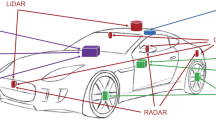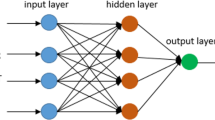Abstract
Energy consumption is one of the main challenges in wireless sensor networks. Additionally, in target tracking algorithms, it is expected to have a longer lifetime for the network, when a better prediction algorithm is employed, since it activates fewer sensors in the network. Most target tracking methods activate a large number of nodes in sensor networks. This paper proposes a new tracking algorithm reducing the number of active nodes in both positioning and tracking by predicting the target deployment area in the next time interval according to some factors including the previous location of the target, the current speed and acceleration of the target without reducing the tracking performance. The proposed algorithm activates the sensor nodes available in the target area by predicting the target position in the next time interval. The problem of target loss is also considered and solved in the proposed tracking algorithm. In the numerical analysis, the number of nodes involved in target tracking, energy consumption and the network lifetime are compared with other tracking algorithms to show superiority of the proposed algorithm.










Similar content being viewed by others
References
Li, J., & Zhou, Y. (2010). Target tracking in wireless sensor networks. Shanghai: Department of Automation, Shanghai Jiao Tong University.
Tran, S., & Yang, T. (2006). Evaluations of target tracking in wireless sensor networks. Houston: University of Houston.
Bhatti, S., & Xu, J. (2009). Survey of target tracking protocols using wireless sensor network. West Yorkshire: School of Computing University of Leeds Leeds.
Chen, W. P., Hou, J. C., & Sha, L. (2004). Dynamic clustering for acoustic target tracking in wireless sensor networks. IEEE Transactions on Mobile Computing, 3(3), 258–271.
Atia, G. K., Veeravalli, V. V., & Fuemmeler, J. A. (2011). Sensor scheduling for energy-efficient target tracking in sensor networks. IEEE Transactions on Signal Processing, 59, 4923–4927.
Sheng, X., Hu, Y.-H., & Ramanathan, P. (2005). Distributed particle filter with GMM approximation for multiple targets localization and tracking in wireless sensor network. In Proceedings of the 4th international symposium on information processing in sensor networks, Los Angeles, CA, USA, pp. 181–188.
Chuang, S. C. (2005). Survey on target tracking in wireless sensor networks. Hsinchu City: Dept. of Computer Science, National Tsing Hua University.
Zoghi, M., & Kahaei, M. H. (2010). Adaptive sensor selection in wireless sensor networks for target tracking. IET Signal Processing, 4(5), 530–536.
Chang, W.-R., Lin, H.-T., & Cheng, Z.-Z. (2008). CODA: A continuous object detection and tracking algorithm for wireless ad hoc sensor networks. In Proceedings of the 5th IEEE consumer communications and networking conference, Las Vegas, NV, USA, pp. 168–174.
Guo, M., Olule, E., Wang, G., & Guo, S. (2010). Designing energy efficient target tracking protocol with quality monitoring in wireless sensor networks. Journal of Supercomputing, 51(2), 131–148.
Guojun, W., Huan, W., Jiannong, C., & Minyi, G. (2007). Energy-efficient dual prediction-based data gathering for environmental monitoring applications. In Proceedings of the IEEE wireless communications and networking conference (WCNC’07), Kowloon, China, pp. 3516–3521.
Pattem, S., Poduri, S., & Krishnamachari, B. (2003). Energy-quality tradeoffs for target tracking in wireless sensor networks. In Proceedings of the 2nd workshop on information processing in sensor networks, California, USA, pp. 32–46.
Anand, M. T. (2005). Target tracking in wireless sensor networks. PhD thesis, Louisiana State University.
Juan, F., & Hongwei, Z. (2011). Adaptive energy conservation strategy for target tracking sensor networks. In 3rd International conference on communication software and networks (ICCSN), IEEE, pp. 386–391.
Gangwar, P. K., Singh, Y., & Mohindru, V. (2014). An energy efficient zone-based clustering approach for target detection in wireless sensor networks. In Recent advances and innovations in engineering (ICRAIE). IEEE, pp. 1–7.
Saeed, M. J., Han, L., & Muyeba, M. K. (2014). An energy efficient and resource preserving target tracking approach for wireless sensor networks. 9th International symposium on communication systems, networks & digital signal processing (CSNDSP). IEEE, pp. 232–237.
Zhang, M., Gong, C., Feng, Y., & Lu, Y. (2009). A novel energy-efficient dynamic target tracking protocol for wireless sensor networks. In International conference on networks security, wireless communications and trusted computing. IEEE, pp. 649–652.
Rahman, A. A. U., Naznin, M., & Mollah, M. A. I. (2010). Energy-efficient multiple targets tracking using target kinematics in wireless sensor networks. In Fourth international conference on sensor technologies and applications (SENSORCOMM). IEEE, pp. 275–280.
Xiao, J., Liu, W., He, Y., & Qin, G. (2014). Energy-efficient sensor scheduling scheme for target tracking in wireless sensor networks. In The 26th Chinese control and decision conference (2014 CCDC). IEEE, pp. 1869–1874.
Mirsadeghi, M., & Mahani, A. (2014). Energy efficient fast predictor for WSN-based target tracking. Annals of Telecommunications, 70(1–2), 63–71.
Zhou, F., Trajcevski, G., Avci, B., & Scheuermann, P. (2012). Sensor synchronization for energy efficient multiple object tracking. In 9th IEEE international conference on networking, sensing and control (ICNSC), pp. 139–144.
Chen, J., Cao, K., Li, K., & Sun, Y. (2011). Distributed sensor activation algorithm for target tracking with binary sensor networks. Cluster Computing, 14(1), 55–64.
Guo, M., Olule, E., Wang, G., & Guo, S. (2010). Designing energy efficient target tracking protocol with quality monitoring in wireless sensor networks. The Journal of Supercomputing, 51(2), 131–148.
Khedr, A. M., & Osamy, W. (2011). Effective target tracking mechanism in a self-organizing wireless sensor network. Journal of Parallel and Distributed Computing, 71(10), 1318–1326.
Atia, G. K., Veeravalli, V. V., & Fuemmeler, J. (2011). Sensor scheduling for energy-efficient target tracking in sensor networks. IEEE Transactions on Signal Processing, 59(10), 4923–4937.
Wang, X., Xing, G., Zhang, Y., Lu, C., Pless, R., & Gill, C. (2003). Integrated coverage and connectivity configuration in wireless sensor networks. St. Louis: Department of Computer Science and Engineering, Washington University in St. Louis.
Zhang, H., & Hou, J. C. (2005). Maintaining sensing coverage and connectivity in large sensor networks. Urbana: Department of Computer Science, University of Illinois at Urbana Champaign.
Author information
Authors and Affiliations
Corresponding author
Rights and permissions
About this article
Cite this article
Shokouhi Rostami, A., Mohanna, F. & Keshavarz, H. A Novel Energy-Aware Target Tracking Method by Reducing Active Nodes in Wireless Sensor Networks. Wireless Pers Commun 95, 3585–3599 (2017). https://doi.org/10.1007/s11277-017-4013-x
Published:
Issue Date:
DOI: https://doi.org/10.1007/s11277-017-4013-x




